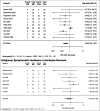Intramedullary Fixation Versus Plate Fixation of Distal Fibular Fractures: A Systematic Review
- PMID: 38996216
- PMCID: PMC11239172
- DOI: 10.5435/JAAOSGlobal-D-24-00119
Intramedullary Fixation Versus Plate Fixation of Distal Fibular Fractures: A Systematic Review
Abstract
Introduction: The purpose of this systematic review and meta-analysis was to provide an update of the recent literature comparing clinical outcomes of surgically treated fibular fractures using intramedullary nailing (IMN) with open reduction and internal plate fixation (ORIF).
Methods: A literature search reporting clinical outcomes after IMN or ORIF of the distal fibula was conducted on PubMed. Inclusion criteria consisted of original studies; studies focusing on clinical outcomes after IMN or IMN and ORIF published before May 11, 2022; studies with at least 5 patients; and studies reporting union rates, complication rates, and patient-reported outcomes such as American Orthopaedic Foot and Ankle Society (AOFAS) and Olerud-Molander scores.
Results: Of 2,394 studies identified, a total of 29 studies (4 LOE-I, 2 LOE-II, 6 LOE-III, 17 LOE-IV) were included consisting of 1,850 IMN patients and 514 plate patients. The pooled mean age of IMN patients was 58 years (95% confidence interval [CI], 54 to 62, I2 = 42%) versus 57 years (95% CI, 53 to 62, I2 = 49%) in ORIF. Union rates for IMN patients revealed a 99% union rate (95% CI, 0.98 to 1.00, I2 = 20%) versus 97% union rate for ORIF patients (95% CI, 0.94 to 0.99, I2 = 0%). Studies that compared IMN with ORIF revealed no difference in union rates (risk ratio [RR] = 0.99, 95% CI, 0.96 to 1.02, I2 = 0%). IMN patients showed a 15% complication rate (95% CI, 0.09 to 0.23, I2 = 89%), whereas plate patients had a complication rate of 30% (95% CI, 0.18 to 0.46, I2 = 63%). When comparing studies with both treatments, IMN patients had a significantly lower risk of complications (RR = 0.49, 95% CI, 0.29 to 0.82, I2 = 50%). The IMN group trended toward a higher mean AOFAS and Olerud-Molander score than the plate group by 4.53 (95% CI, -14.58 to 23.65, I2 = 85%) and 3.54 (95% CI, -2.32 to 9.41, I2 = 76%) points, respectively.
Conclusion: Current literature reveals near equivalence in union rates and a markedly lower risk of complications when comparing IMN with plate fixation. While IMN patients had higher AOFAS and Olerud-Molander scores, these differences were not statistically significant. Notably, subgroup analyses indicated that rates of symptomatic implant and removal of implant were comparable between IMN and ORIF, which may indicate that wound-related complications were reduced in the minimally invasive IMN technique. While the high cost of IMN implants remains a barrier to their widespread adoption, the long-term benefits of reducing complications, specifically associated with wound complications in high-risk populations, may greatly improve quality of care for patients with distal fibula fractures. Additional research and cost-effectiveness analyses are warranted to fully assess the long-term benefits and economic feasibility of using IMN fixation for distal fibula fractures.
Level of evidence: Therapeutic Level IV.
Copyright © 2024 The Authors. Published by Wolters Kluwer Health, Inc. on behalf of the American Academy of Orthopaedic Surgeons.
Figures











References
-
- Shibuya N, Davis ML, Jupiter DC: Epidemiology of foot and ankle fractures in the United States: An analysis of the National Trauma Data Bank (2007 to 2011). J Foot Ankle Surg 2014;53:606-608. - PubMed
-
- Kannus P, Palvanen M, Niemi S, Parkkari J, Jarvinen M: Increasing number and incidence of low-trauma ankle fractures in elderly people: Finnish statistics during 1970-2000 and projections for the future. Bone 2002;31:430-433. - PubMed
-
- Bariteau JT, Hsu RY, Mor V, Lee Y, DiGiovanni CW, Hayda R: Operative versus nonoperative treatment of geriatric ankle fractures: A Medicare Part A claims database analysis. Foot Ankle Int 2015;36:648-655. - PubMed
-
- Koval KJ, Zhou W, Sparks MJ, Cantu RV, Hecht P, Lurie J: Complications after ankle fracture in elderly patients. Foot Ankle Int 2007;28:1249-1255. - PubMed
-
- Bartonicek J: Early history of operative treatment of fractures. Arch Orthop Trauma Surg 2010;130:1385-1396. - PubMed
Publication types
MeSH terms
LinkOut - more resources
Full Text Sources
Medical
Research Materials

